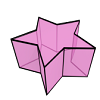Modeling and manipulating spacetime objects in a true 4D model
Keywords:
4D GIS, spacetime, spatiotemporal modeling, spatiotemporal operations, geometric modelingAbstract
The concept of spacetime has long been used in physics to refer to models that integrate 3D space and time as a single 4D continuum. We argue in this paper that it is also advantageous to use this concept in a practical geographic context by realizing a true 4D model, where time is modeled and implemented as a dimension in the same manner as the three spatial dimensions. Within this paper we focus on 4D vector objects, which can be implemented using dimension-independent data structures such as generalized maps. A 4D vector model allows us to create and manipulate models with actual 4D objects and the topological relationships connecting them, all of which have a geometric interpretation and can be constructed, modified, and queried. In this paper we discuss where such a 4D model fits with respect to other spatiotemporal modeling approaches, and we show concretely how higher-dimensional modeling can be used to represent such 4D objects and topological relationships. In addition, we explain how the 4D objects in such a system can be created and manipulated using a small set of implementable operations, which use simple 3D space and 1D time inputs for intuitiveness and which modify the underlying 4D model indirectly.

Downloads
Published
Issue
Section
License
Copyright (c) 2017 Ken Arroyo Ohori, Hugo Ledoux, Jantien Stoter

This work is licensed under a Creative Commons Attribution 4.0 International License.
Articles in JOSIS are licensed under a Creative Commons Attribution 3.0 License.
